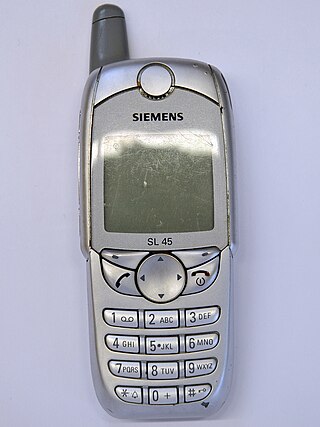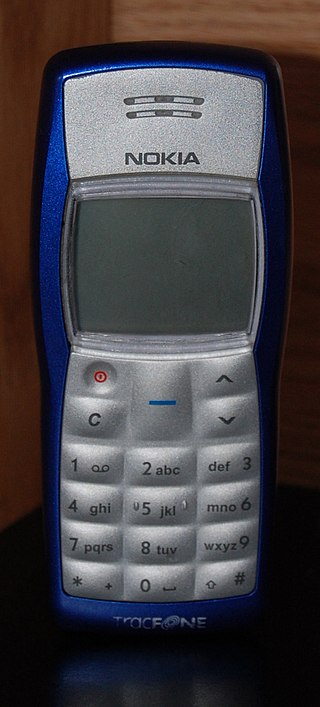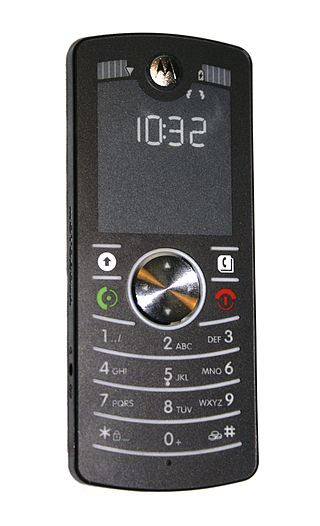A ringtone is the sound made by a telephone to indicate an incoming telephone call. Originally referring to the sound of electromechanical striking of bells or gongs, the term refers to any sound by any device alerting of an incoming call.

An alarm clock or alarm is a clock that is designed to alert an individual or group of people at a specified time. The primary function of these clocks is to awaken people from their night's sleep or short naps; they can sometimes be used for other reminders as well. Most alarm clocks make sounds; some make light or vibration. Some have sensors to identify when a person is in a light stage of sleep, in order to avoid waking someone who is deeply asleep, which causes tiredness, even if the person has had adequate sleep. To turn off the sound or light, a button or handle on the clock is pressed; most clocks automatically turn off the alarm if left unattended long enough. A classic analog alarm clock has an extra hand or inset dial that is used to show the time at which the alarm will ring. Alarm clock functions are also used in mobile phones, watches, and computers.

The Siemens SL45 was the first mobile phone with memory expansion and an MP3 player, which debuted in late 2000. An improved version, the SL45i, was also the first phone to have a Java virtual machine.
The Nokia 3210 is a GSM cellular phone, announced by Nokia on 18 March 1999.

The Nokia 1100 is a basic GSM mobile phone produced by Nokia. Over 250 million 1100s have been sold since its launch in late 2003, making it the world's best selling phone handset and the best selling consumer electronics device in the world at the time. The model was announced on 27 August 2003 and was discontinued in September 2009.

A mobile phone feature is a capability, service, or application that a mobile phone offers to its users. Mobile phones are often referred to as feature phones, and offer basic telephony. Handsets with more advanced computing ability through the use of native code try to differentiate their own products by implementing additional functions to make them more attractive to consumers. This has led to great innovation in mobile phone development over the past 20 years.
iMelody is a non-polyphonic ringtone exchange object format, used for mobile phones [Extension: .imy], defined by Ericsson and Sony Ericsson together with other manufacturers and is based on Ericsson's proprietary eMelody format. This ringtone format also supports codes that can control the vibration motor, backlight, LED lights and volume of the device. The iMelody format was made because the eMelody had some musical limitations.
The Nokia 6131/Nokia 6133 is a Nokia clamshell phone introduced by Nokia in February 2006.

The Motorola F3, frequently known as the Motofone, is a candybar style GSM mobile phone from Motorola, released on 28 November 2006. It was the first mobile phone to use an electronic paper display.
Phantom vibration syndrome or phantom ringing syndrome is the perception that one's mobile phone is vibrating or ringing when it is not. Other terms for this concept include ringxiety, fauxcellarm and phonetom and phantom phone signals. According to Michael Rothberg, the term is not a syndrome, but is better characterised as a tactile hallucination since the brain perceives a sensation that is not actually present. WebMD published an article on phantom vibration syndrome with Rothberg as a source. Several other articles have been published in 2010s, including in NPR, Bustle, CBS News, and Psychology Today.
A vibrator is a mechanical device to generate vibrations. The vibration is often generated by an electric motor with an unbalanced mass on its driveshaft.

The Samsung SCH-u470, or Juke and Verizon Wireless Juke, is a mobile phone offered exclusively by Verizon Wireless. It was announced on 2 October 2007, and released that same year on Q4 in three colors: red, teal, and navy (blue). The phone is a music player when closed, and can be swiveled for use of the mobile phone. It also has a VGA-resolution camera with a special "night shot" mode for taking photos in low-light conditions.
OhMiBod is an American company that manufactures sex toys, based in New Hampshire, United States.
The Motorola Aura was a series of luxury mobile phones from Motorola, which are part of the 4LTR line. The series was announced in October 2008 and was made available for purchase by December of that year. Though initially planned as a series, only one model, the Aura R1, was released. In 2009, three special editions of the Aura R1 followed: the Aura Diamond Edition, Aura Celestial Edition, and another Aura Diamond Edition. Marketed as a luxury device, the Aura had a price tag of US$2000, was constructed using more expensive materials, such as stainless steel and sapphire, and was packaged in a wooden box.

The Samsung E1107 is a mobile phone designed for a rural lower budget market. The handset has a solar cell on the back and is made from recycled materials. It was first released in India on July 10, 2009 with an initial price of ₹2,799.
A personal safety app or SOS app is a mobile application designed to provide individuals with additional security and assistance in various situations. These apps offer a range of features and functionalities that users can utilize to enhance their personal safety. Common features include emergency alerts, location sharing, safety tips, SOS buttons, audible alarms, and community safety reporting. Users can employ these apps to quickly send emergency alerts, share their real-time location with trusted contacts, and access safety-related information and resources.

Silent mode is a setting available on mobile phones and pagers that, when activated, disables the ringtones and, in some cases, also the vibrating alerts or alarm. Unlike the airplane mode, the silent mode still allows the device to receive and send calls and messages. This quiet option may be useful in meetings, speeches, libraries, museums, or places of worship. In some places it is mandatory to use the silent mode or to switch off the device.
The Nokia 7210 is a handset by Nokia, built on the Series 40 1st Edition software platform and enabled with J2ME (Java). The device features text and picture messaging, WAP browser, Stereo FM radio, Polyphonic ringtones, two preinstalled games and a 1.5", 128x128 pixel, 4,096 color display. It was the first Nokia phone for the mass market with a colour display and with polyphonic ringtones.
A smart ring is a compact wearable electronic device that combines mobile technology with features for convenient on-the-go use. These devices, typically designed to fit on a finger like a traditional ring, offer functionalities like mobile payments, access control, gesture control, and activity tracking. Smart rings can connect to smartphones or other devices, and some can operate independently, communicating with cloud-based systems or performing standalone tasks. While lacking traditional displays, they respond to contextual cues, such as proximity to payment terminals or specific gestures.








